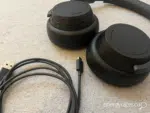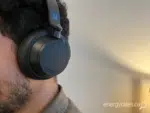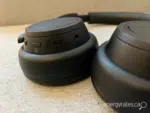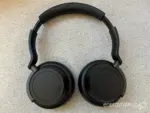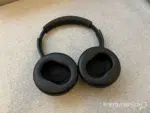Contents
Microsoft Surface Headphones 2 Review
When the opportunity to write a Microsoft Surface Headphones 2 review arose, I was excited to get started, not only because I have much to say about it but also because I’ve been using these headsets for more than a year and a half. I’ve seen the good and the bad.
After innumerous hours of music streaming to hundreds of video calls, I can say I really enjoy the Surface Headphones 2’s dynamic, clear and well-balanced sound for both work and casual settings. They are also stylish and relatively affordable headphones, especially when compared to some of its competitors, like the Sony and Bose models.
But there’s more to it, including these headphones’ comfortable fit and not-so-great noise cancellation. Read on for an honest, long-term review of the Microsoft Surface Headphones 2.
PROS | CONS |
|
|
Battery life
As a wired headphones person, I’m always attentive to battery life when reviewing wireless devices. For me, the ideal battery life for a pair of headsets is something that neither require me to charge it every day nor blocks me from living spontaneously. It frustrates me when I feel like listening to music and realize my headphones don’t have enough battery.
Based on that, I separated my experience with the Microsoft Surface Headphones 2 into two scenarios:
- 1) When I’m working in the office 9-5 and have it on for phone calls only.
- 2) When I’m working in the office 9-5 and have it on for phone calls and listen to music in-between calls.
In scenario 1, I went for as much as five days without charging these headphones. I was able to use it for a full workweek and still had 3 hours of battery life left on Friday evening.
In scenario 2, I noticed that I had to charge it every other day, which is not too bad for work use, but I can imagine this not being ideal if you don’t use it under such a specific schedule or setup. For people on the go always listening to music, the 16-hour battery life could become a bother, since it will require charging time quite often, if not daily.
It’s a good battery life if you use it in the office only and don’t make phone calls all the time. I have a few 25-minute meetings every day and usually listen to music most of the day while working, so I charge my headsets almost daily. And even though I’m not exactly a heavy user, I got frustrated a couple of times when realizing I had to charge my headphones in the middle of the afternoon — whether because I forgot to charge them after work the day before, or because I wasn’t planning to.
Although the battery life is not one of the Surface Headphones 2’s strongest points, they have two features that help offset this flaw. The charging time is really quick: 10-15 minutes of charging will give you 2-4 hours of playback. And it doesn’t take much more than an hour for a full charge.
Another great battery-related feature is the low-battery alerts you get as playback time starts to wind down. You hear it every hour when there are 2-3 hours left only and they get more frequent as the battery goes low. Yet, this is never too annoying or irritating; it’s a low-key reminder, which is great for the office.
Sound quality
Because the Microsoft Surface Headphones 2 are quite versatile, we separated the audio quality into two sections: sound quality (focusing on music and videos) and call quality for videoconferencing, which will be discussed later.
The sound quality is probably my favourite thing about these headphones. As I said before, I use the Surface 2 for a wide range of tasks, however, listening to music is probably what I do most, and the Microsoft headphones have a terrific sound.
Although the Surface Audio app had an equalizer and other audio features, I always keep them on the default settings.
The sound is always dynamic, clear, well balanced, and with a great bass.
I listen to a lot of rap, jazz, blues, and Brazilian music, which all benefit a lot from strong bass notes. I highlight here King Krule’s The OOZ, Ari Lennox’s Shea Butter Baby, and Beyoncé’s Renaissance. These three records sounded incredible with my Surface Headphones 2, even when compared to my Beats headphones.
The high-pitched sounds also come out great. For jazz songs, the trumpets sound crisp clear, not as high quality as the lower notes or bass instruments, but still great.
For a pair of headsets so focused on daily work tasks, I was positively surprised to have such a great music listening experience with the Surface Headphones 2.
Call quality
Calls were the main reason why I started using the Microsoft Surface Headphones 2. As someone who has multiple meetings every day, I needed headsets with a greater mic quality (so I could sound as clear as possible), a good sound quality, and good connectivity with both videoconferencing software and a wide range of devices.
The Surface 2 marked all the checkboxes, and even more.
As Teams-certified headphones, this product was built with a focus on Microsoft Teams integration, which is the software I use for most of my video calls. I also used it with other software like Google Meet and Zoom and never had issues. On the contrary, people would hear me with clarity.
These headsets are so good for calls that they even make you forget you’re on an online meeting sometimes.
Because it’s a Microsoft audio product, it has a few useful Teams-focused features, like the Teams call button, which is a shortcut to Teams meetings. You just need to press the button on the right side earcup, and it will take you to your next scheduled meeting. This is incredibly useful when you’re in a hurry and have multiple tabs open.
Although the Surface Headphones 2’s compatibility with Microsoft Teams is outstanding, I’d recommend these headsets for anyone who needs crisp clear call audio quality, regardless of the videoconferencing software they use.
The only issue I can recall after using it for more than a year is that due to its movement sensors (it enters pause mode when you remove it from your head and leave it horizontally), it would mute my mic or enter sleep mode based on my movements. This doesn’t happen too often as you usually don’t move your head that abruptly during a meeting, but it happens. If I recall it right, the two times I had this issue were when I had to pick something I had dropped on the floor, and it recognized as if I had removed the headphones.
Bluetooth connectivity
The Microsoft Surface Headphones 2 have an excellent wireless connectivity. I use these headphones around 30 hours a week and never have any issues; it’s been just flawless.
Although I don’t switch devices all the time (I have quite a consistent setup, and the USB dock is always connected to my laptop), the Bluetooth connection has always been stable, without any glitches or delays.
I have also paired them with my iPhone many times. All I had to do was press the power button for five seconds and then they would become available for pairing with any near devices. These headphones worked amazingly well both with Windows and iOS.
For this specific review, I even tried specific experiments, like going for walks across the house and trying to get as far as possible from the connected device to see for how far it could maintain a good connection, and still I had zero issues.
Noise cancellation
With 13 levels of active noise cancellation, the Surface Headphones 2 are great for the average office’s background noise; it will even turn it into some sort of hum that keeps you concentrated, like a white noise machine, but lower.
For much louder noises, however, like construction sounds, these headsets sometimes made things worse. While writing this review, I was lucky enough to have construction going on at the same time in the two apartments below and above mine. I noticed that when things got loud, the noise cancellation system would generate these artificial background sounds that would sometimes feel even louder than the actual construction noise. I would remove the headphones and realize the sounds weren’t that bad.
That being said, these headphones will work well in most work setups. I used it in a crowded airport seating area; and it worked well and kept me concentrated. Later, during the flight, I put on some music and had the most relaxing experience ever; it cancelled (or merged with) the airplane’s white noise and created a cozy atmosphere that made me even forget I was on a 10-hour flight.
It’s important to note I usually leave it at the default settings. For this test, however, all impressions were based on the maximum noise cancellation level, so I could have the same comparison standard.
Comfort and fit
When you buy over-ear headphones, you’re probably looking for a comfortable listening experience, and you will certainly have it with these Microsoft headphones.
The earcup cushions are soft and lightweight, making the earpads amazingly comfortable. They fully cover my ears (I have medium-sized ears, I would say), and I don’t feel any pressure or pain after hours of use.
Although I found it easy to adjust them to my head, I noticed that the headband would sometimes put pressure at the top of my head after long hours of use. The headband is soft to the touch, and it is cushioned. However, I have the impression that the rubber cover would sometimes pull my hair and cause pressure at the top of my head.
Chatting with a friend who owns the same model, they complained about the same thing and have a similar impression about it. It doesn’t happen too often, but it was a bit annoying at the beginning.
Design
The Microsoft Surface Headphones 2 has a simple yet elegant design. It looks fresh, modern, and straightforward all at the same time. It fits most tastes and setups, whether you use it at the office for videoconferencing or if you are looking for a good pair of headphones for listening to music.
Although these are big headsets, they are also lightweight and not too visible (in the sense that they do not draw a lot of attention to them.) Chances are high that most people won’t even notice you’re wearing headphones due to its simple design, which could be great for a more professional setting.
Looks aside, one of these headphones most useful features is also one of their biggest drawbacks: shortcut buttons. As mentioned above, the Surface 2 has a button that allows you to enter Teams meetings with a single click. Even though this is useful, this button can also cause some annoyance due to its position. I often press this button accidentally when trying to change the volume (and when I say often I mean once a week) and end up playing the Teams calling sound out of nowhere, or, worse, joining a meeting before I was ready to. This is not a big deal if you don’t use Microsoft Teams though.
Still on the usability side, the Surface 2’s volume button, which is an on-ear dial, is incredibly convenient. You can literally turn the volume up, which saved me quite a bit of time over the past year. I am so satisfied with this feature that it almost makes me forgive any other design/usability issues this product has.
Speaking of usability drawbacks, portability is the Surface Headphones 2’s biggest problem. Even with rotating ear cups, which rotate 180 degrees, it’s just not portable enough. Without folding hinges, it gets harder to carry your headphones with you all the time, especially if you don’t have a large bag with you. For such a bulky pair of headphones, you need to be able to fold it; otherwise, it’s just too big.
Price and availability
The Microsoft Surface Headphones 2 were released on May 6, 2020, and there are currently two colours available: Light Gray and Matte Black.
Their price range has been fluctuating since they were released, but it’s usually CAD $250-350 in Canada, and $199.99-249.99 in the United States.
You can still find these headphones on most retailer’s sites, including Amazon and Best Buy, however, I found the best prices on the official Microsoft website. They will often have promotional prices or discounts for businesses.
Microsoft also has great customer support, which makes things much easier not only while purchasing your device but also if you ever need coverage or warranty support.
Accessories
The Surface Headphones 2’s accessories include a carrying case, a USB cable, an audio cable, and a USB dongle for laptops.
There isn’t much to say about these accessories other than they’re the expected standard set of accessories for a pair of headphones these days. I personally don’t use the carrying case that often as I find it too bulky and, guess what, not very portable. However, it’s a good way of keeping your audio device protected in a safe place.
Verdict
The Microsoft Surface Headphones 2 have some creative differentials that save them from being a plain pair of headsets, like the incredibly convenient multi-device connectivity, and the adjustable noise cancellation, which could be better, but it still provides 13 levels for you to choose from.
These rare features, however, may not be enough if you are always on the go or need to use them for a diverse range of tasks. I found that the Surface Headphones 2 reached their highest potential when used at the office at a more settled setup, like for phone or video calls, and listening to music and podcasts.
I’m not sure how happy I would be if these were my day-to-day headphones, like the type that you take the subway with or go for a walk wearing them. There are much more portable and even stylish options for that at a similar price point.
For relatively affordable headphones (some of their competitors are $200 more expensive), these are great work headsets, almost perfect for businesses. They have an astonishing sound quality, a great mic, and are super soft to the ear even after long hours of use. They feel like the ideal upgrade to your average work headsets, especially if you use the Microsoft Suite and software like Microsoft Teams. It’s a great integration overall.
OVERALL RATING: 7.8/10
Tech Specs
Specifications | Microsoft Surface Headphones 2 |
Dimmensions | Length: 204 mm (8.03”) |
Weight | .29 kg (.64 lbs) |
Colours | Light Gray and Matte Black |
Frequency response | 20 – 20kHz |
Noise cancellation | Up to 30 dB for active noise cancellation |
Speaker | 40 mm Free Edge driver |
Charging time | Full charge in less than 2 hours |
Battery life | Up to 18.5 hours of music listening time or up to 15 hours of voice calling on Microsoft Teams |
Audio cable length | 1.2 m |
Inputs | USB-C™ connector 3.5 mm audio connector |
Compatibility | Windows 11 Home/Pro, Windows 10, Android 9 or 10, IOS 12 or 13, Bluetooth 4.1/4.2/5.0* |
Audio Codec | SBC and aptX™ |
Buttons/controls | Power button, Mute button, Volume dial (right ear), Noise Cancellation dial (left ear) |
Accessories | Surface Headphones 2 |
